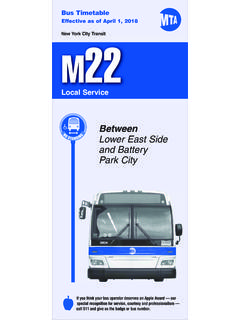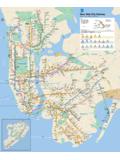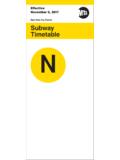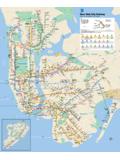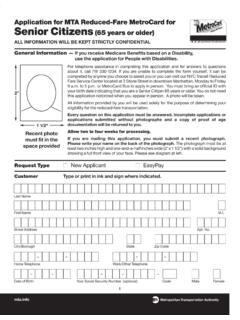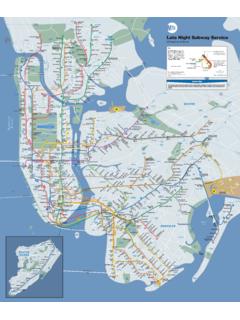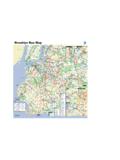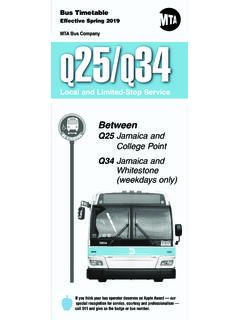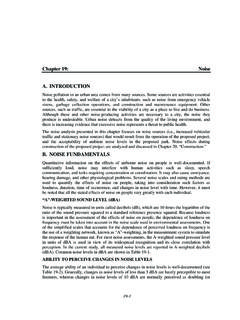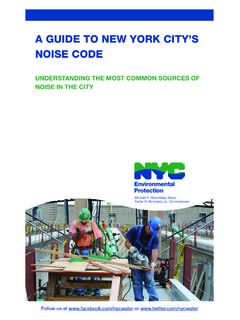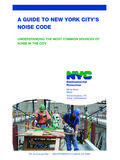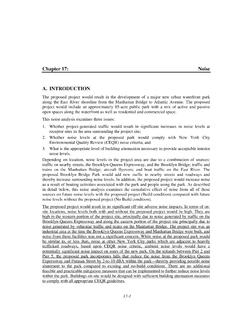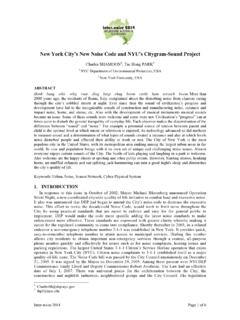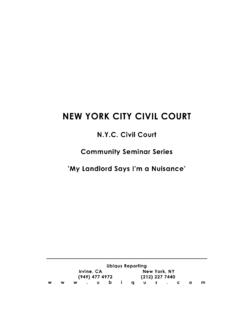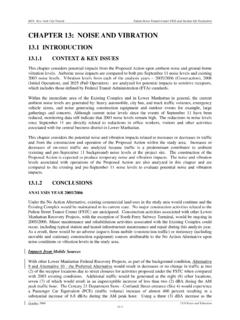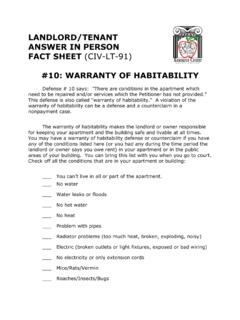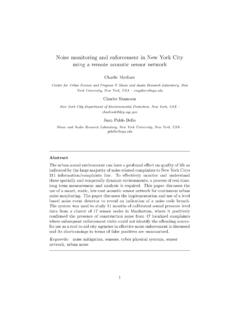Transcription of 5.11 NOISE AND VIBRATION - MTA
1 metropolitan transportation authority /New york city Transit South Ferry Terminal Project May 2004 5-73 NOISE and VIBRATION NOISE AND VIBRATION Introduction This section assesses the potential for NOISE and VIBRATION impacts from construction and operation of the proposed South Ferry Terminal Project. Because the project is proposed to be funded by the Federal Transit Administration (FTA), the NOISE and VIBRATION analyses were conducted according to FTA guidelines published as Transit NOISE and VIBRATION Impact Assessment (1995).
2 This section is divided into two main analyses: 1) airborne NOISE ; and 2) VIBRATION and ground-borne NOISE . Each of the analyses includes a description of the assessment standards and criteria, a description of existing conditions, a description of future conditions with and without the Proposed Action for both the construction and operational phases of the project, and mitigation measures where impacts are identified. Environmental Performance Commitments The Proposed Action will be implemented with Environmental Performance Commitments (EPCs).
3 These are measures that will be proactively implemented within the design and construction of the project to avoid or reduce potential adverse impacts with regard to NOISE and VIBRATION . They include the following: Where practicable, individual project construction activities will be scheduled to avoid or minimize adverse impacts. Construction activities will be coordinated with projects under construction in adjacent and nearby locations to avoid or minimize impacts. The condition of surrounding buildings, structures, infrastructure, and utilities shall be considered, where appropriate.
4 Contingency measures such as sequencing of operations, alternative construction methods, and source reduction measures will be prepared in the event established limits are exceeded (for the South Ferry Project, the FTA construction NOISE criteria apply). NOISE Characteristics NOISE is typically measured in units called decibels (dB). Because the volume of audible sound is perceived as loudness, the dependence of loudness on frequency must be taken into account in the NOISE scale used in environmental assessments. One of the simplified scales that accounts for the dependence of perceived loudness on frequency is a weighting network known as A weighting.
5 Through the use of this weighting scale, a measurement system may simulate the response of the human ear. Sound levels that are measured using an A-weighted decibel scale are generally expressed as dBA. Throughout this section, NOISE levels are expressed as dBA. Several examples of NOISE metropolitan transportation authority /New york city Transit South Ferry Terminal Project May 2004 5-74 NOISE and VIBRATION pressure levels in dBA are listed in Table 5-26. Table 5-27 shows the average ability of the human ear to perceive changes in NOISE levels.
6 Table 5-26 A-Weighted (dBA) Levels of Typical NOISE Environment A-weighted Overall Level NOISE Environment 120 Uncomfortably loud (32 times as loud as 70 dBA) Military jet airplane takeoff at 50 feet. 100 Very loud (8 times as loud as 70 dBA) Jet flyover at 1,000 feet Locomotive pass-by at 100 feet. 80 Loud (2 times as loud as 70 dBA) Propeller plane flyover at 1,000 feet. Diesel truck moving 40 mph at 50 feet. 70 Moderately loud Freeway at 50 feet from pavement edge at 10 Vacuum cleaner (indoor).
7 60 Relatively quiet (1/2 as loud as 70 dBA) Air condition unit at 100 feet. Dish washer at 10 feet (indoor). 50 Quiet (1/4 as loud as 70 dBA) Large transformers. Small private office (indoor). 40 Very quiet (1/8 as loud as 70 dBA) Birds calls. Lowest limit of urban ambient sound. 10 Extremely quiet (1/64 as loud as 70 dBA) Just audible. 0 Threshold of hearing Source: Federal Agency Review of Selected Airport NOISE Analysis Issues, 1992 Modified by Louis Berger Group, October 1998 Table 5-27 Average Ability to Perceive Changes in NOISE Levels Change (dBA) Human Perception of Sound 2-3 Barely perceptible 5 Readily noticeable 10 A doubling or halving of the loudness of sound 20 A dramatic change 40 Difference between a faintly audible sound and a very loud sound Source: Bolt Beranek and Neuman, Inc.
8 , Fundamentals and Abatement of High-way Traffic NOISE , Report No. PB-222-703. Prepared for Federal High-way Administration, June 1973. It is also possible to characterize the effects of NOISE on people by studying the aggregate response of people in communities (see Table 5-28). The rating method used for this purpose is based on a statistical analysis of the fluctuations in NOISE levels in a community, and integrating the fluctuating sound energy over a known period of time, most typically during one hour or 24-hours.
9 metropolitan transportation authority /New york city Transit South Ferry Terminal Project May 2004 5-75 NOISE and VIBRATION Table 5-28 Community Response to Increases in NOISE Levels Change (dBA) Category Description 0 None No observed reaction 5 Little Sporadic complaints 10 Medium Widespread complaints 15 Strong Threats of community action 20 Very strong Vigorous community action Source: International Standards Organization, NOISE Assess-ment with Respect to Community Responses, ISO/TC 43.
10 (New york : United Nations, November 1969). Because the sound pressure level unit of dBA describes a NOISE level at just one moment and very few noises are constant, other ways of describing NOISE over more extended periods have been developed. One way of describing fluctuating sound is to describe the fluctuating NOISE heard over a specific period as if it had been a steady, unchanging sound. For this condition, a descriptor called the equivalent sound level, Leq, is used. Leq is the constant sound level that, in a given situation and period ( , 1 hour, denoted by Leq(1), or 24 hours, denoted as Leq(24)), conveys the same sound energy as the actual time-varying sound.
